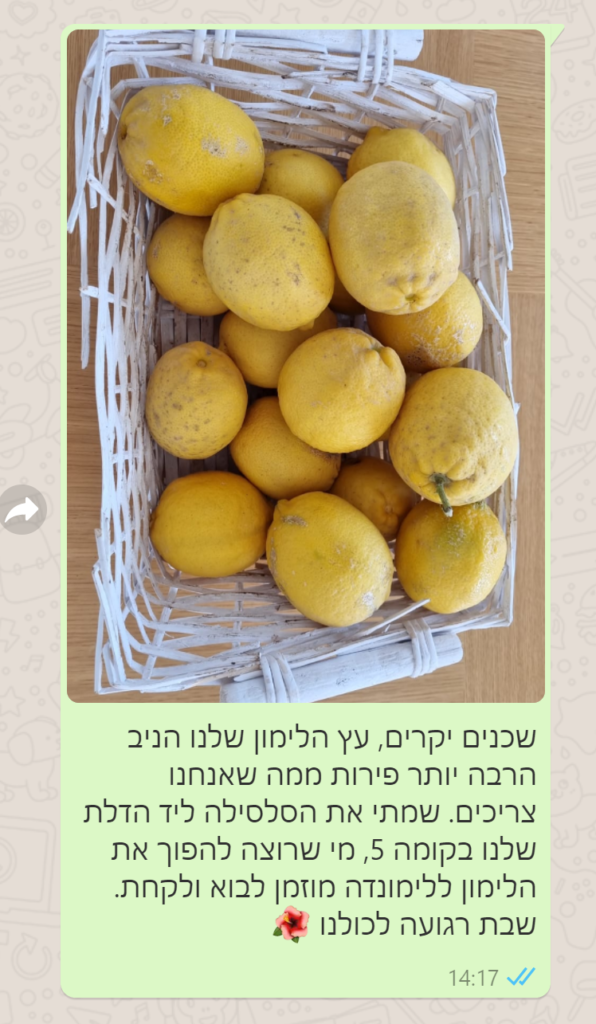I have a lemon tree at home. Every year, it grows dozens of fresh, yellow lemons. We use them for salad dressing or cakes, but seriously, how many lemons does one need? The tree grows many more than we use ourselves. I send some to my family and friends, but still, this year we had many lemons left on the tree. I texted all my neighbors – there are 18 other families in my building – and said that they can come to take fresh lemons. I sent them photos of the beautiful yellow fruit. I added smiles and said we are happy to give them away since we can’t use them all. And guess what? No one showed up.
After a few more days have gone by and no one came to take our amazing lemons, I was afraid that they will rot. I decided that whether my neighbors want them or not, I don’t want them to rot on the tree, so I picked all the lemons and put them in a basket. I put the basket outside my doorstep and texted the neighbors again, telling them that it’s there for them to come and take whatever they want whenever they want:

The text in the image says: “dear neighbors, our lemon tree grew many more fruits than we need. I put this basket next to our door on the 5th floor. If you want to make lemonade out of lemons feel free to come and get some. Have a lovely weekend”
Honestly, I didn’t think it was going to work. I offered these same lemons before, and no one wanted them! My conclusion was that no one needed lemons, and I assumed that they will stay there for a few days until they start to rot, and then I’ll simply need to throw them away.
The next morning, when I left home, I looked at the basket and it seemed a bit emptier. I was so surprised that I went back to the photo to check if anything changed. When I came back home that day, about half of the lemons in the basket were gone, and 24 hours later there was nothing left. I was so surprised that I followed this process closely, to understand if there was one person who suddenly needed many lemons. The answer is no, they were gone 1-2 lemons at a time. After all, how many lemons does one need?
So what happened here? Did I generate a sudden demand for lemons? Maybe, but most likely not. I removed barriers from the customer journey and allowed my neighbors to get to the value more quickly and easily. That’s when the demand – that was probably there all along – was able to surface.
What can you do to help the demand surface in your own product? Here are a few techniques that will help you improve the customer journey and help them buy from you.
Be Super Crisp on the Value
One of the principles of product-led growth is to lead your customers straight to the value that they can get from your product. The sooner that “a-ha!” moment happens, the better. Honestly, this is a great practice even if you are not working in product-led growth. It’s just great product work.
To do that, you must be able to define that moment, and that is derived directly from the value that your customers expect to get from the product.
But what is this value exactly? Can you phrase it clearly? Note that I deliberately said the value that your customers expect to get and not the value you think they can get, because sometimes they are very different from each other, and there is only one that can win – the customer’s one in this case. So you must understand how they see it and what they want exactly. The words matter here, both since they will be translated into marketing materials that must speak the customer’s language and since they help you be on spot with the value proposition itself (which later translates into product features).
This is one of the hardest things to do since there are so many possibilities. Even in my very simple example, I could think of many different value propositions: free lemons, fresh lemons, free lemons at your doorstep without you needing to do anything, and even things like contribution to sustainability or forming a community with your neighbors.
In retrospect, I believe that in my case the real value was free lemons at your doorstep without you needing to do anything. Had I known that in advance, I probably would have thought of the basket idea from the get-go and wouldn’t simply stumble upon it when I was afraid my lemons were about to rot.
This isn’t trivial, because I thought “free lemons” was something of great value. It turns out that not entirely. It was nice, I’m sure, but obviously, it wasn’t important enough for them to come to knock on my door.
Make sure you fully understand the value that your customers expect to get from the product. Once you have done that, manifesting it in the journey itself is much easier.
Tell the Journey From Their Eyes
This is a simple trick, yet extremely important and not always trivial to perform. Tell the customer journey from your customer’s perspective. Many people I work with a start there and immediately continue with the company’s perspective. It happens since there are often many details missing – they haven’t thought about them or don’t have certain information, so it is much easier to go back to what you already know and tell it that way. But that wouldn’t be good enough because it is these exact details that are missing that would make the difference.
To make sure you keep the customer perspective at all times, tell the story in the first person. Ask yourself how your customer would describe their journey to someone else. You want it to be as detailed as possible so that one step leads to the other and you understand why it makes sense. Also, make sure to include feelings and thoughts. In my case it would look something like this:
I have this neighbor from the 5th floor. She seems nice, we smile at each other in the elevator, but we’re not really friends. Her name is Noa, she has two or three kids, I think. Every now and then she offers us things from her garden – basil, lemons, rosemary, etc. I always think this is really nice, but I never took the opportunity before. The other day she said she put a basket with lemons outside her door. I saw it when I was out, so took a mental note to check on it when we are back. Of course, I forgot, but then someone sent another message in the building group, and then I saw the photo of the lemons again. I thought it would be nice to have a lemon or two at home, I usually don’t bother buying them, so I sent my 6 years old son to get us some. I figured it would be a good opportunity for him to be responsible and practice his independence.
You see that when you keep it in the first person, there’s no escape. You have to address everything that happens. If I told this in the third person it would probably translate to something like that: “they get the text message, they go to the 5th floor, they take lemons”. And that’s exactly where the hidden barriers reside. Uncover them by sticking to the first person and to your customers’ entire state of mind and life events. Remember that they don’t just sit there and wait for your product, there are many other things that happen at the same time for them, and you need to blend well with all of them.
Understand the “Why Not”
Another way to uncover hidden barriers is to look for them explicitly. Once you told the story from their perspective, tell it again but explain where they failed. For example, in my story above, it could have been that they forgot about it since they were outside, and that’s where it ended. Try to play devil’s advocate and read the story again wearing the devil’s hat. Annotate the story with “yes, but” phrases of everything that could go wrong. Try to stick to the customer perspective here too, and use the first-person trick to do so.
Another good way of doing it is conducting a pre-mortem. Go into the future and assume that you failed. Then ask yourself what went wrong. Where was the pitfall? What did you miss in the bigger picture that caused everything to collapse? This is a great methodology for foreseeing barriers and identifying risks in advance. I highly recommend using it for everything you do, not just related to the customer journey mentioned here.
* * *
A few weeks after the lemon basket story, I was sitting in my living room when suddenly someone knocked on my door. It was a Wednesday afternoon, I just finished a coaching session in the CPO Bootcamp, and I wasn’t expecting any guests. I opened the door, and a young girl stood there. I knew she is the daughter of the neighbor from the first floor. I said hi, and the girl politely said that her mom asked if we happen to have one or two lemons that she can get. You see, once they saw value in your product, they are willing to work harder to get it again. But they wouldn’t be willing to do so the first time. That’s on you.










